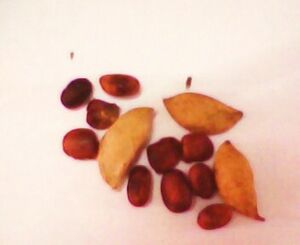Pongamia oil facts for kids
Pongamia oil is a special kind of oil that comes from the seeds of the Millettia pinnata tree. This tree grows naturally in warm parts of Asia. You might also hear it called Pongamia pinnata or Pongamia glabra. Because it's found in many places, it has lots of different names, like honge oil, kanuga oil, karanja oil, and pungai oil. The name Pongamia is often used for the tree itself.
Contents
Growing Pongamia Trees
The Millettia pinnata tree originally comes from South and Southeast Asia. Now, it's grown all over the world! People know it by names like Indian beech or karanja.
These trees start making seed pods when they are about five years old. They produce more and more pods each year until they are about ten years old, then the amount stays steady. The seeds are usually collected in the spring. Each seed is quite small, weighing about 1 to 2 grams. One tree can give you anywhere from 10 to over 50 kilograms of seeds!
In the past, people would knock the pods off the branches with sticks. Then, they would use mallets or stones to remove the outer shell of the seeds. Today, scientists are looking into ways to use machines to harvest the seeds.
What is Pongamia Oil Like?
Pongamia oil is taken out of the seeds in a few ways. Sometimes, machines press the oil out, which is called expeller pressing or cold pressing. Other times, chemicals are used to pull the oil out, which is known as solvent extraction.
The oil itself can be yellowish-orange or brown. It has a lot of natural fats called triglycerides. It also has a strong, unpleasant taste and smell. This is because of some bitter things inside it, like karanjin and pongamol.
The exact makeup of Pongamia oil can change a bit. This depends on the type of Millettia pinnata tree, the soil it grows in, and the weather. But generally, it's made up of different kinds of fatty acids.
How Pongamia Oil is Used
Traditional Uses
For thousands of years, people have used Pongamia oil for many things. It was used as lamp oil to light homes. It also helped in leather tanning, which is how animal skins are made into leather. People used it to make soap and as a lubricant to make machines run smoothly.
Because of its bad taste, smell, and the fact that it can be harmful, it's not used for cooking. However, in traditional medicine, it has been used to help with skin problems and liver issues.
It's also known to be toxic to fish. So, it has been used to help catch fish in some areas.
Biodiesel Fuel
Many scientists have studied how to turn Pongamia oil into biodiesel. Biodiesel is a type of fuel made from plants or animal fats that can be used in engines, just like regular diesel.
Research shows that processed Pongamia oil can meet the standards for biodiesel fuels. Sometimes, Pongamia oil can even be mixed with other oils, like palm oil, to make a better fuel. For example, mixing it can help the fuel flow better in cold weather or last longer.
One thing to note is that Pongamia oil biodiesel can get thick or cloudy at temperatures around 19 degrees Celsius (66 degrees Fahrenheit). It can also start to solidify at 15 degrees Celsius (59 degrees Fahrenheit). This means it might not work well as a fuel in very cold places.


